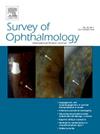The influence of scleral buckle on choroidal architecture: An unexplored link with the spectrum of acquired overload choroidopathy?
IF 5.9
2区 医学
Q1 OPHTHALMOLOGY
引用次数: 0
Abstract
Scleral buckling (SB) has been a cornerstone in the surgical management of rhegmatogenous retinal detachment for decades, achieving success rates above 85 %; however, its impact on choroidal architecture and hemodynamics has been less thoroughly explored until recent advancements in ocular imaging techniques. We synthesize current evidence on the effects of SB surgery on choroidal structure and circulation, examining its implications for postoperative complications and exploring a potential link with the newly described spectrum of acquired venous overload choroidopathy (AVOC). Various imaging modalities including indocyanine green angiography, optical coherence tomography (OCT), and OCT angiography have demonstrated that SB induces both transient and sometimes persistent alterations in choroidal thickness, blood flow patterns, and vascular morphology, with encircling buckles showing more pronounced and enduring effects than segmental approaches. Notably, persistent subretinal fluid (PSF), a known complication following SB surgery, appears associated with alterations in choroidal architecture, particularly in eyes with preexisting pachychoroid features, suggesting potential overlap with the AVOC spectrum characterized by impaired venous outflow from the choroid. The mechanical indentation of the sclera by the buckle may compress vortex veins, disrupt the Starling resistor mechanism regulating choroidal fluid dynamics, and contribute to venous congestion, with implications for long-term visual outcomes. While vascular adaptations often mitigate these effects through the development of collateral circulation, in some cases, particularly with encircling bands, persistent choroidal alterations may contribute to complications like PSF. Further research is needed to establish a definitive link between SB-induced choroidal changes and the AVOC spectrum, which could significantly influence patient selection, surgical technique, and postoperative management strategies for RRD.
巩膜扣对脉络膜结构的影响:与获得性超载脉络膜病谱系的未探索联系?
几十年来,巩膜屈曲(SB)一直是孔源性视网膜脱离手术治疗的基石,成功率在85%以上;然而,它对脉络膜结构和血流动力学的影响,直到最近眼部成像技术的进步才得到彻底的探讨。我们综合了目前关于SB手术对脉络膜结构和循环影响的证据,研究了其对术后并发症的影响,并探索了与新描述的获得性静脉超载脉络膜病(AVOC)谱的潜在联系。多种成像方式,包括吲青素绿血管造影、光学相干断层扫描(OCT)和OCT血管造影已经证明,SB诱导脉络膜厚度、血流模式和血管形态的短暂和有时持续的改变,与节段性方法相比,环形扣带显示出更明显和持久的影响。值得注意的是,持续性视网膜下液(PSF)是SB手术后的已知并发症,似乎与脉络膜结构的改变有关,特别是在先前存在厚脉络膜特征的眼睛中,这表明可能与以脉络膜静脉流出受损为特征的AVOC频谱重叠。扣环对巩膜的机械压痕可能会压缩旋涡静脉,破坏调节脉络膜流体动力学的斯特林电阻机制,并导致静脉充血,影响长期视力结果。虽然血管适应通常通过侧支循环的发展来减轻这些影响,但在某些情况下,特别是有环绕带的情况下,持续的脉络膜改变可能导致PSF等并发症。sb诱导的脉络膜改变与AVOC谱之间的明确联系需要进一步的研究,AVOC谱可能会显著影响RRD的患者选择、手术技术和术后管理策略。
本文章由计算机程序翻译,如有差异,请以英文原文为准。
求助全文
约1分钟内获得全文
求助全文
来源期刊

Survey of ophthalmology
医学-眼科学
CiteScore
10.30
自引率
2.00%
发文量
138
审稿时长
14.8 weeks
期刊介绍:
Survey of Ophthalmology is a clinically oriented review journal designed to keep ophthalmologists up to date. Comprehensive major review articles, written by experts and stringently refereed, integrate the literature on subjects selected for their clinical importance. Survey also includes feature articles, section reviews, book reviews, and abstracts.
 求助内容:
求助内容: 应助结果提醒方式:
应助结果提醒方式:


